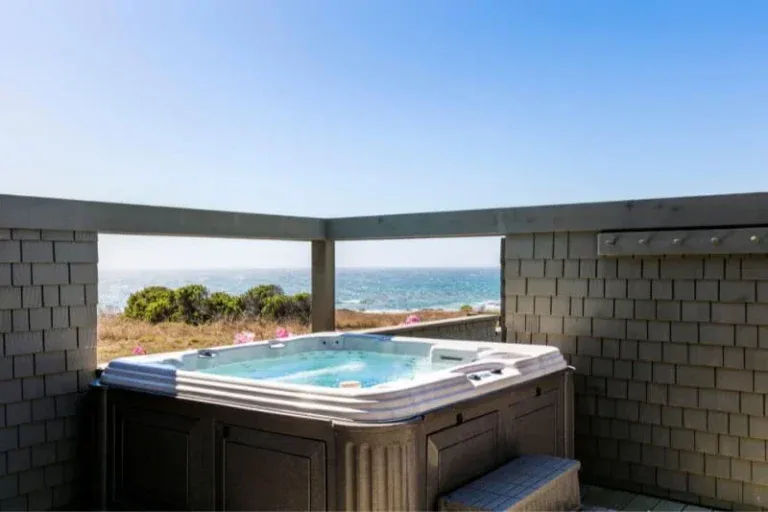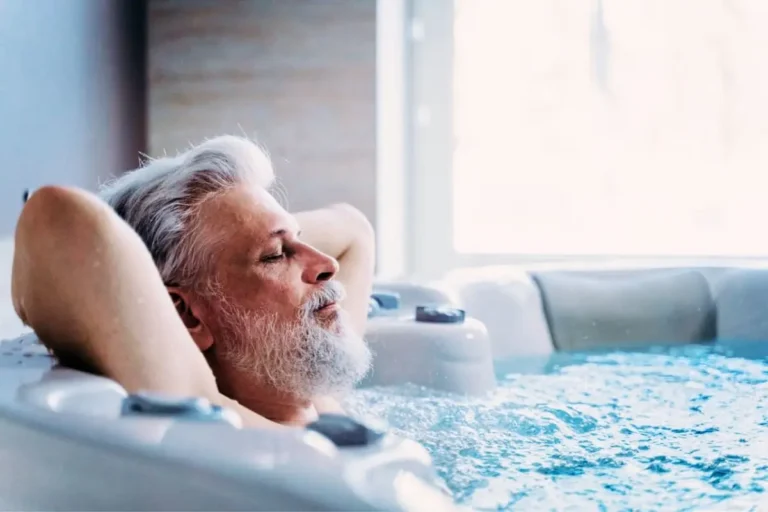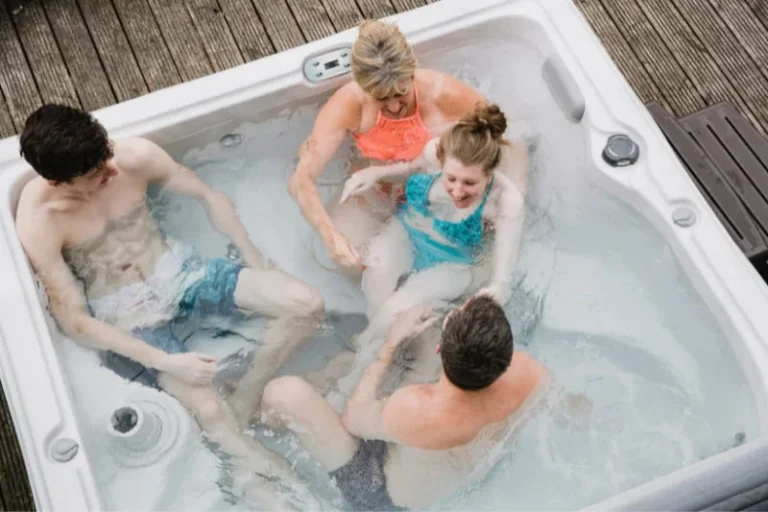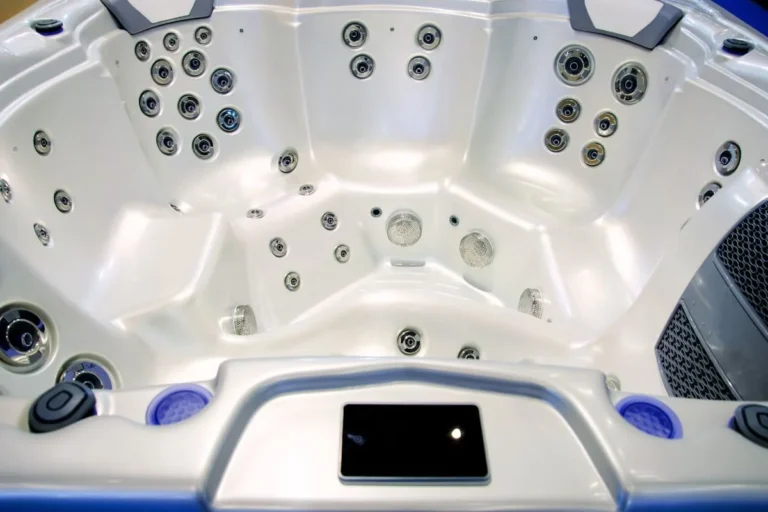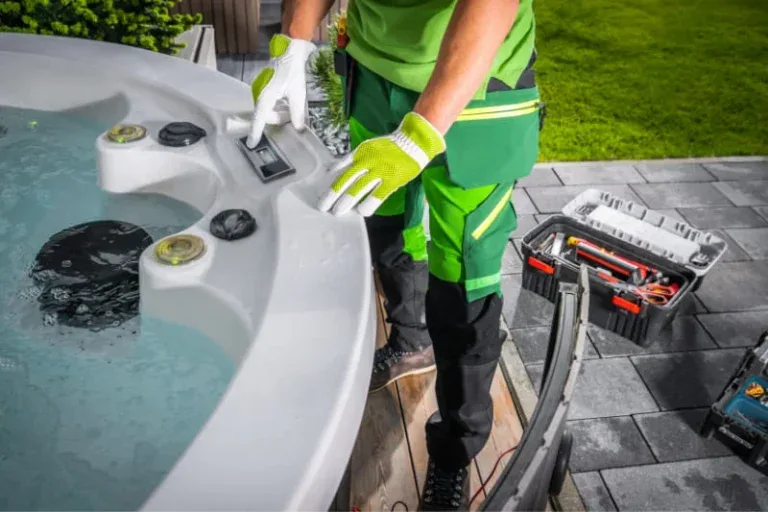How to Get Rid of a Hot Tub: Complete Removal Guide 2025
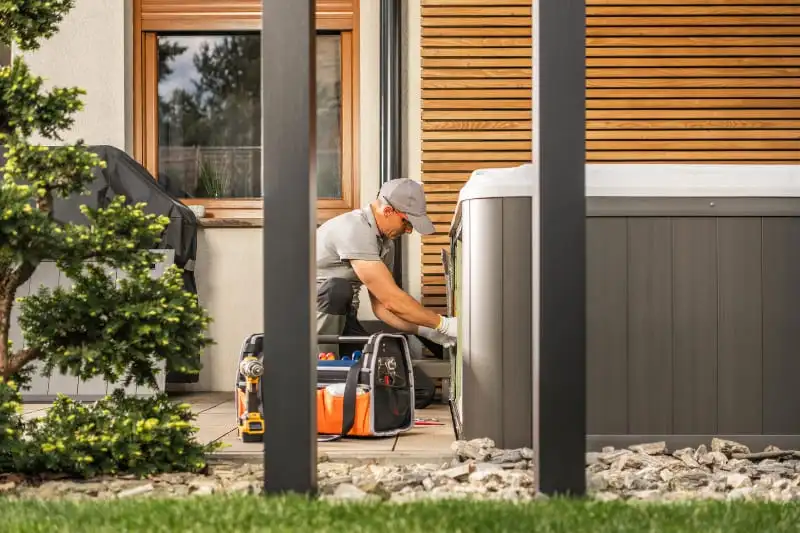
Got a hot tub that’s seen better days? Maybe you’re staring at that once-beloved backyard centerpiece, thinking it’s time for an upgrade. Or perhaps you inherited one with your new home, and it’s just taking up valuable space.
Key Takeaways
- Start with preparation: Turn off power, drain water completely, and clear access paths (takes 2-4 hours)
- Choose your method: Sell for $500-$3,000, trade-in for $200-$1,000 credit, donate for tax benefits, or hire professionals for $300-$800
- DIY removal requires a reciprocating saw, safety gear, and 2-4 people (total cost $175-$450)
- Professional services handle everything, including electrical disconnect and eco-friendly disposal (completed in 2-4 hours)
- Legal requirements: 23+ states ban electronics disposal – check local regulations before disposing (source: eridirect.com)
- Timeline expectations: Selling takes 1-4 weeks, professional removal same-day, DIY weekend project
- Safety first: Always use a certified electrician for electrical disconnect on hardwired units
Here’s a reality check (source: consumeraffairs.com):
- There are about 7.3 million hot tubs across America.
- Consumers keep their spas for an average of just seven and a half years.
- Nearly 40% of all newly purchased hot tubs are sold secondhand or given away.
That means millions of homeowners face this exact disposal challenge regularly.
Whether your spa removal is driven by costly repairs, energy efficiency concerns, or wanting that deck space back for summer entertaining, you’re about to discover something important.
Getting rid of a hot tub doesn’t require a construction crew or massive expense. From profitable hot tub disposal methods that put money back in your pocket to eco-friendly recycling options, this guide reveals every strategy available.
Table of Contents
Why Remove Your Hot Tub?
Understanding your motivation helps determine the best hot tub disposal approach. Most homeowners decide on spa removal for these reasons:
1. Costly Repairs and Maintenance: When pump replacement exceeds $800 or heater repairs hit $600+, disposing of your hot tub often makes more financial sense than continued repairs.
2. Energy Efficiency Upgrades: Modern spas use 50-70% less energy than models from the early 2000s. Your monthly electricity savings alone can justify hot tub removal and replacement.
3. Space Reconfiguration: Deck renovations, pool installations, or landscaping projects frequently require removing hot tub units to optimize outdoor living areas.
4. Property Value Enhancement: Real estate agents report that outdated, non-functioning spas can actually decrease property appeal. This makes professional hot tub removal a smart investment.
5. Safety Concerns: Cracked shells, exposed wiring, or unstable positioning create liability issues that demand immediate hot tub disposal.
Preparing Your Hot Tub for Removal: Essential Safety Steps
Proper preparation prevents accidents and ensures smooth spa removal regardless of your chosen disposal method.
Electrical Safety First
Turn off the power at the main breaker – never just unplug the spa.
Most hot tub electrical disconnect procedures require a certified electrician for hardwired units. Attempting DIY electrical work during hot tub removal can result in serious injury or code violations.
Complete Water Drainage
Drain all water completely using the built-in drain valve or a submersible pump. Standard garden hoses work for most drainage. Check local water disposal regulations – some areas restrict chlorinated water discharge to storm drains.
Access Planning and Site Preparation
Measure all pathways, gates, and doorways. Most hot tub removal projects fail due to poor access planning. Standard spas measure 7-8 feet square and weigh 400-900 pounds empty.
Clear obstacles, including patio furniture, plants, and decorative elements. Protect existing landscaping with plywood sheets during professional hot tub removal or DIY projects.
Trading In Your Hot Tub for Maximum Value
Hot tub trade-in programs offer convenience plus financial benefits. This makes it the preferred choice for many homeowners upgrading their spas.
How Dealer Trade-In Programs Work
Established dealers evaluate your spa’s condition, age, and brand to determine trade-in hot tub value. Expect $200-$1,500+ credit depending on your unit’s specs and market demand.
Schedule in-home evaluations for accurate assessments. Dealers consider pump condition, shell integrity, cover quality, and overall functionality when calculating hot tub trade-in offers.
Maximizing Your Trade-In Value
- Clean thoroughly and perform minor repairs before evaluation.
- Replace burned-out lights, fix loose panels, and ensure all jets function properly.
- Document your maintenance history, including recent part replacements, chemical treatments, and professional service records. Well-maintained spas command higher trade-in hot tub values.
Time your trade strategically – spring and early summer typically yield better trade values due to increased demand.
When Trade-In Makes Perfect Sense
Choose hot tub trade-in programs when you’re purchasing from the same dealer, want professional spa removal included, and value convenience over maximum profit. Most dealers handle all hot tub disposal logistics as part of the trade agreement.
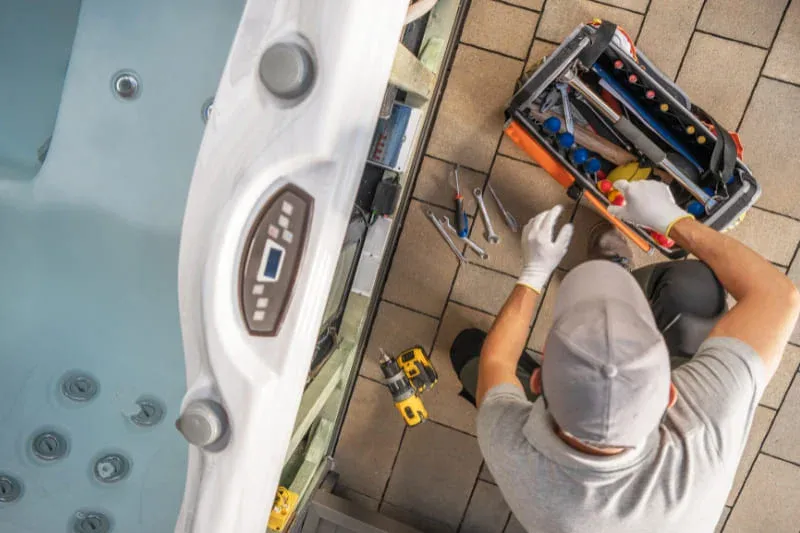
Selling Your Used Hot Tub: Maximizing Profit
Selling used hot tubs can recover significant value, especially for well-maintained models from premium brands.
Market Research and Pricing Strategy
Research comparable used hot tub sales on Facebook Marketplace, Craigslist, and specialized spa forums. Quality 5-7 year old spas typically sell for 30-50% of the original retail price.
Factor in removal costs when setting prices. Buyers often expect sellers to handle delivery or offer significant discounts for buyer pickup.
Preparing Your Spa for Sale
Professional cleaning dramatically improves sales prospects. Steam clean the shell, condition the cover, and replace filter cartridges.
Take high-quality photos showing the spa from multiple angles, control panels, and any included accessories. Well-lit images significantly increase buyer interest in used hot tub listings.
Best Platforms for Hot Tub Sales
- Facebook Marketplace reaches the most local buyers with integrated messaging and payment options.
- Craigslist remains popular for used hot tub sales, but requires more caution regarding buyer verification.
- Specialized spa forums connect you with knowledgeable buyers willing to pay premium prices for quality equipment.
Donating Your Hot Tub: Community Impact
Donating hot tubs benefits local organizations while providing potential tax advantages for functional units.
Organizations That Accept Spa Donations
1. Community centers often welcome hot tub donations for therapy programs or member amenities. Contact recreation departments in your area about donation policies.
2. Schools with aquatic programs may use donated spas for hydrotherapy or sports medicine applications.
3. Nonprofit rehabilitation centers frequently need hot tub equipment for physical therapy programs.
Related: Hot Tub Benefits
Tax Benefits and Documentation
Obtain written donation receipts detailing the spa’s fair market value for tax deduction purposes. Consult your tax advisor about specific deduction limits and requirements.
Most organizations cannot handle hot tub transportation, so budget for professional spa removal services even when donating. This typically costs $200-$400 but ensures safe delivery.
Professional Hot Tub Removal Services: What to Expect
Professional hot tub removal eliminates safety risks and disposal headaches while ensuring environmentally responsible spa disposal.
Service Process and Timeline
Removal companies typically complete in 2-4 hours depending on access challenges and dismantling requirements.
Licensed contractors handle electrical disconnect, dismantling, and transportation to appropriate recycling centers or disposal facilities.
Cost Factors for Professional Removal
Hot tub removal cost ranges from $300-$800 based on:
- Spa size and weight
- Access difficulty (stairs, narrow gates, etc.)
- Hot tub disposal method (recycling vs. landfill)
- Local labor rates and disposal fees
Additional charges may apply for electrical disconnect ($100-$200) or site cleanup services.
Choosing the Right Removal Company
Verify insurance coverage and licensing before hiring hot tub removal services. Uninsured contractors create liability risks for property damage.
Ask about disposal methods – environmentally conscious companies prioritize hot tub recycling over landfill disposal.
Get written estimates from multiple spa removal companies to ensure competitive pricing and service terms.
DIY Hot Tub Removal: Tools and Safety Procedures
DIY hot tub removal offers maximum cost savings but requires proper planning, tools, and safety measures.
Essential Tool Requirements
1. Reciprocating saw (Sawzall) with demolition blades for cutting fiberglass and plastic components
2. Safety equipment including:
- Heavy work gloves
- Safety glasses
- Dust masks (N95 minimum)
- Steel-toe boots
3. Hand tools such as screwdrivers, wrenches, and pliers for dismantling pumps and electrical components
4. Transportation equipment, including dollies, straps, and access to a pickup truck or trailer
Step-by-Step DIY Removal Process
- Complete preparation steps outlined earlier (power disconnect, drainage, access clearing).
- Remove exterior panels carefully to access internal components.
- Disconnect plumbing lines and remove pumps, heaters, and control systems.
- Cut the shell systematically into manageable pieces using the reciprocating saw.
- Separate materials for appropriate disposal – metal components for scrap yards, plastic for recycling centers.
Safety Considerations for DIY Projects
1. Never attempt an electrical disconnect on hardwired spas without certified electrician assistance. Hot tub electrical work requires specific knowledge of GFCI systems and local codes.
2. Use proper lifting techniques and recruit 2-3 helpers for heavy component removal. Most hot tub shells weigh 300-500 pounds, even when cut into sections.
3. Wear appropriate protective gear throughout the dismantling process. Fiberglass particles and dust created during DIY hot tub removal can cause respiratory irritation.
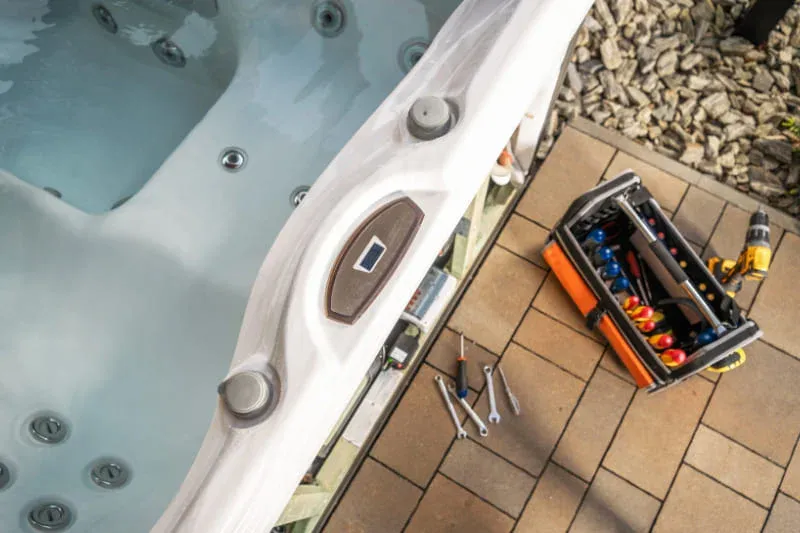
Recycling and Environmental Disposal Options
Hot tub recycling keeps valuable materials out of landfills while supporting environmental sustainability.
Materials That Can Be Recycled
- Metal components, including pumps, heaters, and frame materials, have significant scrap value and are readily accepted by recycling centers.
- Plastic shells made from acrylic or ABS can often be recycled through specialized plastic processing facilities.
- Fiberglass components require specialized recycling, but many areas now offer fiberglass processing services.
Finding Local Recycling Resources
Contact municipal waste departments about hot tub recycling programs and approved disposal sites.
Scrap metal dealers typically purchase pumps, heaters, and metal framework components.
Specialized recycling centers may accept plastic and fiberglass components – call ahead to confirm acceptance policies.
Environmental Regulations
State regulations increasingly restrict appliance disposal in landfills. California, New York, and Massachusetts have specific requirements for spa disposal.
Electronics bans in 25 states affect the disposal of control systems and electrical components from spas.
Understanding Hot Tub Disposal Costs
Hot tub removal costs vary significantly based on your chosen disposal method and local market conditions.
DIY Cost Breakdown
- Tool purchases/rental: $50-$150 (saw, safety gear, truck rental)
- Disposal fees: $25-$100, depending on local transfer station rates
- Electrical disconnect: $100-$200 if professional assistance is required
Total DIY costs: $175-$450
Professional Service Pricing
- Standard removal: $300-$600 for straightforward access situations
- Complex removal: $500-$800 for difficult access or large spas
- Recycling surcharge: $50-$100 additional for eco-friendly disposal
Potential Revenue Streams
- Scrap metal value: $50-$200 for pumps, heaters, and metal components
- Parts sales: $100-$500 if you sell functional components individually
- Whole unit sales: $500-$3,000+ for working spas, depending on condition
Local Regulations and Transfer Station Options
Municipal waste regulations significantly impact your hot tub disposal options and costs.
State-by-State Disposal Restrictions
Appliance restrictions vary by region – some areas completely prohibit hot tub disposal in municipal landfills.
Transfer Station Procedures
- Municipal transfer stations often accept large items for fees ranging $20-$75 per load.
- Scheduling requirements may apply for oversized items like spas – call ahead to arrange hot tub disposal appointments.
- Weight and size limits could require dismantling even for transfer station disposal.
Creative Repurposing Ideas
Before pursuing hot tub disposal, consider these innovative repurposing options that extend your spa’s useful life.
Water Feature Conversions
Transform into a pond by adding a rubber liner, aquatic plants, and circulation pumps for a unique garden focal point.
Alternative Uses
- Children’s play areas – convert to a sandbox or ball pit with proper drainage modifications
- Storage solutions – weatherproof storage for pool toys, garden tools, or outdoor equipment
- Planter conversions – drill drainage holes and create raised garden beds for vegetables or flowers
Your Next Steps
Hot tub removal doesn’t have to be stressful when you choose the right approach for your situation and budget.
Whether you prioritize profit through selling, convenience through trade-in programs, community impact through donation, or environmental responsibility through recycling, each method offers distinct advantages.
Start with preparation – a safe electrical disconnect and complete drainage form the foundation of a successful spa removal, regardless of your chosen method. Budget appropriately by getting quotes from multiple sources and factoring in all associated costs, including transportation and disposal fees.
Choose environmentally responsible disposal whenever possible. Hot tub recycling keeps valuable materials in circulation while reducing landfill waste.
Ready to reclaim that backyard space? Contact local removal services for quotes, research trade-in opportunities at spa dealers, or gather your tools for a weekend DIY hot tub removal project. Your perfect outdoor living space is just one removal away from becoming reality.

“Become a Sauna Expert Overnight!”
Grab Your “FREE” Sauna E-book NOW!
Get your hands on the ultimate sauna manual. From history to DIY setups, our free guide has it all.

As a Chartered Accountant turned sauna enthusiast, I bring a unique blend of analytical skills and hands-on experience to the world of heat therapy. With over a decade dedicated to researching and testing sauna products and practices, I’ve developed a deep understanding of this field. A the founder of HomeInDepth.com, I provide reliable, easy-to-understand information on all aspects of saunas. My goal is to guide you through every step of your sauna journey, offering meticulously researched, unbiased advice to help you make informed decisions and create your perfect sauna experience. I’m always happy to hear from sauna lovers like you—feel free to leave questions or share your own tips in the comments below so we can learn together. Contact me on:

